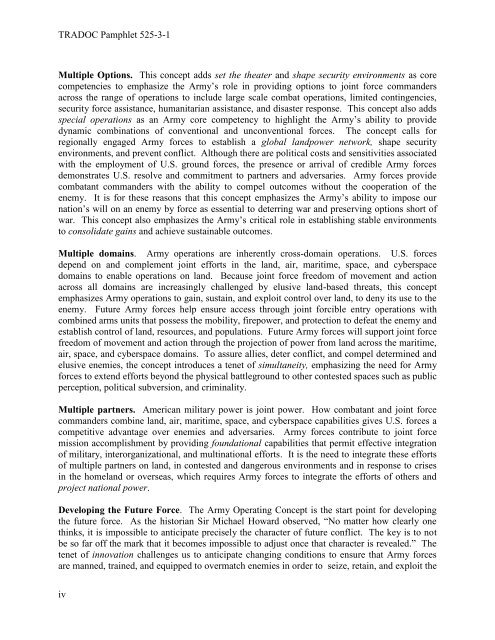TP525-3-1
TP525-3-1
TP525-3-1
You also want an ePaper? Increase the reach of your titles
YUMPU automatically turns print PDFs into web optimized ePapers that Google loves.
TRADOC Pamphlet 525-3-1<br />
Multiple Options. This concept adds set the theater and shape security environments as core<br />
competencies to emphasize the Army’s role in providing options to joint force commanders<br />
across the range of operations to include large scale combat operations, limited contingencies,<br />
security force assistance, humanitarian assistance, and disaster response. This concept also adds<br />
special operations as an Army core competency to highlight the Army’s ability to provide<br />
dynamic combinations of conventional and unconventional forces. The concept calls for<br />
regionally engaged Army forces to establish a global landpower network, shape security<br />
environments, and prevent conflict. Although there are political costs and sensitivities associated<br />
with the employment of U.S. ground forces, the presence or arrival of credible Army forces<br />
demonstrates U.S. resolve and commitment to partners and adversaries. Army forces provide<br />
combatant commanders with the ability to compel outcomes without the cooperation of the<br />
enemy. It is for these reasons that this concept emphasizes the Army’s ability to impose our<br />
nation’s will on an enemy by force as essential to deterring war and preserving options short of<br />
war. This concept also emphasizes the Army’s critical role in establishing stable environments<br />
to consolidate gains and achieve sustainable outcomes.<br />
Multiple domains. Army operations are inherently cross-domain operations. U.S. forces<br />
depend on and complement joint efforts in the land, air, maritime, space, and cyberspace<br />
domains to enable operations on land. Because joint force freedom of movement and action<br />
across all domains are increasingly challenged by elusive land-based threats, this concept<br />
emphasizes Army operations to gain, sustain, and exploit control over land, to deny its use to the<br />
enemy. Future Army forces help ensure access through joint forcible entry operations with<br />
combined arms units that possess the mobility, firepower, and protection to defeat the enemy and<br />
establish control of land, resources, and populations. Future Army forces will support joint force<br />
freedom of movement and action through the projection of power from land across the maritime,<br />
air, space, and cyberspace domains. To assure allies, deter conflict, and compel determined and<br />
elusive enemies, the concept introduces a tenet of simultaneity, emphasizing the need for Army<br />
forces to extend efforts beyond the physical battleground to other contested spaces such as public<br />
perception, political subversion, and criminality.<br />
Multiple partners. American military power is joint power. How combatant and joint force<br />
commanders combine land, air, maritime, space, and cyberspace capabilities gives U.S. forces a<br />
competitive advantage over enemies and adversaries. Army forces contribute to joint force<br />
mission accomplishment by providing foundational capabilities that permit effective integration<br />
of military, interorganizational, and multinational efforts. It is the need to integrate these efforts<br />
of multiple partners on land, in contested and dangerous environments and in response to crises<br />
in the homeland or overseas, which requires Army forces to integrate the efforts of others and<br />
project national power.<br />
Developing the Future Force. The Army Operating Concept is the start point for developing<br />
the future force. As the historian Sir Michael Howard observed, “No matter how clearly one<br />
thinks, it is impossible to anticipate precisely the character of future conflict. The key is to not<br />
be so far off the mark that it becomes impossible to adjust once that character is revealed.” The<br />
tenet of innovation challenges us to anticipate changing conditions to ensure that Army forces<br />
are manned, trained, and equipped to overmatch enemies in order to seize, retain, and exploit the<br />
iv


